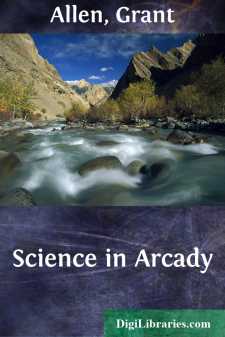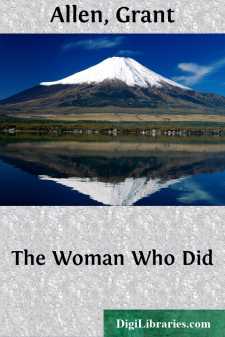Categories
- Antiques & Collectibles 13
- Architecture 36
- Art 48
- Bibles 22
- Biography & Autobiography 813
- Body, Mind & Spirit 142
- Business & Economics 28
- Children's Books 17
- Children's Fiction 14
- Computers 4
- Cooking 94
- Crafts & Hobbies 4
- Drama 346
- Education 46
- Family & Relationships 57
- Fiction 11829
- Games 19
- Gardening 17
- Health & Fitness 34
- History 1377
- House & Home 1
- Humor 147
- Juvenile Fiction 1873
- Juvenile Nonfiction 202
- Language Arts & Disciplines 88
- Law 16
- Literary Collections 686
- Literary Criticism 179
- Mathematics 13
- Medical 41
- Music 40
- Nature 179
- Non-Classifiable 1768
- Performing Arts 7
- Periodicals 1453
- Philosophy 64
- Photography 2
- Poetry 896
- Political Science 203
- Psychology 42
- Reference 154
- Religion 513
- Science 126
- Self-Help 84
- Social Science 81
- Sports & Recreation 34
- Study Aids 3
- Technology & Engineering 59
- Transportation 23
- Travel 463
- True Crime 29
Science in Arcady
by: Grant Allen
Description:
Excerpt
About the middle of the Miocene period, as well as I can now remember (for I made no note of the precise date at the moment), my islands first appeared above the stormy sheet of the North-West Atlantic as a little rising group of mountain tops, capping a broad boss of submarine volcanoes. My attention was originally called to the new archipelago by a brother investigator of my own aerial race, who pointed out to me on the wing that at a spot some 900 miles to the west of the Portuguese coast, just opposite the place where your mushroom city of Lisbon now stands, the water of the ocean, as seen in a bird's-eye view from some three thousand feet above, formed a distinct greenish patch such as always betokens shoals or rising ground at the bottom. Flying out at once to the point he indicated, and poising myself above it on my broad pinions at a giddy altitude, I saw at a glance that my friend was quite right. Land making was in progress. A volcanic upheaval was taking place on the bed of the sea. A new island group was being forced right up by lateral pressure or internal energies from a depth of at least two thousand fathoms.
I had always had a great liking for the study of material plants and animals, and I was so much interested in the occurrence of this novel phenomenon—the growth and development of an oceanic island before my very eyes—that I determined to devote the next few thousand centuries or so of my æonian existence to watching the course of its gradual evolution.
If I trusted to unaided memory, however, for my dates and facts, I might perhaps at this distance of time be uncertain whether the moment was really what I have roughly given, within a geological age or two, the period of the Mid-Miocene. But existing remains on one of the islands constituting my group (now called in your new-fangled terminology Santa Maria) help me to fix with comparative certainty the precise epoch of their original upheaval. For these remains, still in evidence on the spot, consist of a few small marine deposits of Upper Miocene age; and I recollect distinctly that after the main group had been for some time raised above the surface of the ocean, and after sand and streams had formed a small sedimentary deposit containing Upper Miocene fossils beneath the shoal water surrounding the main group, a slight change of level occurred, during which this minor island was pushed up with the Miocene deposits on its shoulders, as a sort of natural memorandum to assist my random scientific recollections. With that solitary exception, however, the entire group remains essentially volcanic in its composition, exactly as it was when I first saw its youthful craters and its red-hot ash-cones pushed gradually up, century after century, from the deep blue waters of the Mid-Miocene ocean.
All round my islands the Atlantic then, as now, had a depth, as I said before, of two thousand fathoms; indeed, in some parts between the group and Portugal the plummet of your human navigators finds no bottom, I have often heard them say, till it reaches 2,500; and out of this profound sea-bed the volcanic energies pushed up my islands as a small submarine mountain range, whose topmost summits alone stood out bit by bit above the level of the surrounding sea. One of them, the most abrupt and cone-like, by name now Pico, rises to this day, a magnificent sight, sheer seven thousand feet into the sky from the placid sheet that girds it round on every side. You creatures of to-day, approaching it in one of your clumsy new-fashioned fire-driven canoes that you call steamers, must admire immensely its conical peak, as it stands out silhouetted against the glowing horizon in the deep red glare of a sub-tropical Atlantic sunset.
But when I, from my solitary aerial perch, saw my islands rise bare and massive first from the water's edge, the earliest idea that occurred to me as an investigator of nature was simply this: how will they ever get clad with soil and herbage and living creatures? So naked and barren were their black crags and rocks of volcanic slag, that I could hardly conceive how they could ever come to resemble the other smiling oceanic islands which I looked down upon in my flight from day to day over so many wide and scattered oceans....












